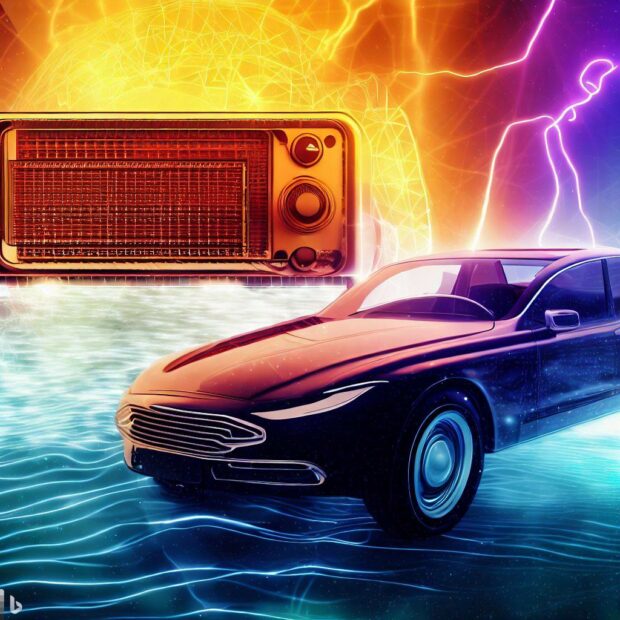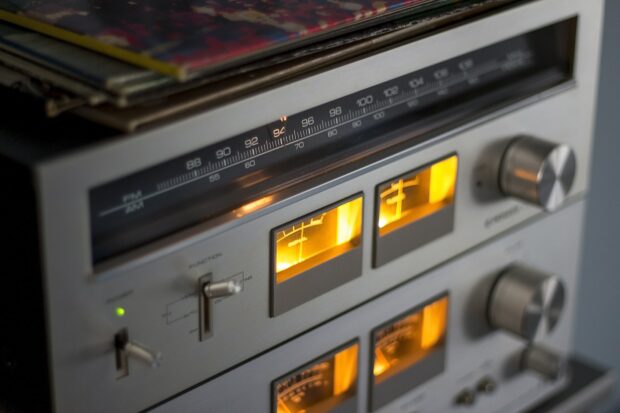On November 2, 1920, the AM radio station KDKA announced the live U.S. Presidential election results between Warren G. Harding and James Cox (spoiler: Harding won). The historic broadcast was the first AM radio broadcast in American history.
In the decades that followed, AM radio was a dominate form of communication and adored by millions of loyal listeners. However, the medium is facing a number of modern challenges, including the electric car industry and the popularity of streaming music services. Can fans save AM radio, or is this the end of the line for this legacy broadcast format?
Electric Cars Interfere With AM Radio
The global transition to electric cars is a major challenge for AM radio. The two technologies simply don’t work well together. Electric cars create electromagnetic interference, which can interfere with AM radio signals. This interference can cause static, noise, and other problems with AM radio reception.

In some cases, the cheapest way for car manufacturers to “fix” the problem is to exclude AM radio from the car altogether. Otherwise, they’d have to build custom shielding for the radio. This is what some automakers, such as Tesla, have done. Other manufactures, like Ford and BMW have also eliminated AM radio from their new electric vehicles.
Unless there’s major resistance from the public or government intervention, more automakers will likely also start removing AM radio from their cars to save money.
Why The Rise Of Electric Cars Is Connected To The Decline Of AM Radio #AMradio #RadioLife #RadioJobs #SaveAMradio Share on XFM And SiriusXM Are More Popular With Drivers Than AM Radio

Another challenge facing AM radio is the medium’s popularity, or lack thereof. Radio is still the dominant entertainment choice for drivers in the United States. According to Pew Research, eight in 10 people over the age of 12 listen to terrestrial radio each week. However, most of those listeners tune in to FM stations, not AM.
The legacy AM radio band still has thousands of loyal listeners, especially in rural areas out of reach of FM signals. But only one in five people still listen to AM radio. Even the newer radio format, Sirius XM satellite radio, is more popular with drivers than AM radio.
And it’s not just FM and Sirius XM that AM has to worry about. After FM, the second most popular audio option in a vehicle is the driver’s phone. For many drivers, if they aren’t listening to FM, it’s often more convenient to switch to their phones than AM radio.
AM Radio Has Poor Sound Quality Compared To New Audio Formats

FM radio overtook AM radio in popularity in the 1960s. This was due to a number of factors, most notably FM’s superior sound quality and stereo capabilities.
In the years since, the audio industry has continued to innovate and create new standards in audio quality for both music and the human voice. Here is a list of some of the major innovations in audio quality that have occurred since the introduction of FM stereo:
- 1961: FM Stereo is introduced.
- 1982: Compact Disc (CD) technology is developed. CDs are digital audio formats that store music in a digital format. This allows for high-quality audio playback with minimal distortion.
- 1987: Digital Audio Tape (DAT) technology is developed. DAT is a digital audio format that stores music on a magnetic tape. DAT offers higher sound quality than cassette tapes, but it is also more expensive.
- 1991: MP3 technology is developed. MP3 is a digital audio format that compresses music files. MP3 files are much smaller than uncompressed audio files, making them easier to store and transfer. However, MP3 files also suffer from some loss of sound quality.
- 1995: High-Resolution Audio (HRA) technology is developed. HRA is a digital audio format that stores music at a higher sampling rate and bit-depth than CD audio. This results in higher sound quality.
- 1999: Super Audio CD (SACD) technology is developed. SACD is a digital audio format that stores music on a disc. SACD offers higher sound quality than CDs, but it is also more expensive.
- 1999: DVD-Audio technology is developed. DVD-Audio is a digital audio format that stores music on a DVD. DVD-Audio offers higher sound quality than CDs, but it is also more expensive.
- 1999: Advanced Audio Coding (AAC-Main Audio Profile) technology is developed. AAC is a digital audio format that compresses music files. AAC files are smaller than MP3 files, but they offer similar sound quality.
- 2001: Lossless audio formats such as FLAC are developed. Lossless audio formats do not compress music files, which means that they offer the highest possible sound quality. However, lossless audio files are much larger than compressed audio files.
- 2012: Dolby Atmos surround sound technology is developed allowing sound to be positioned around the listener in an “atmosphere”. This creates a more immersive listening experience.
These innovations have led to a dramatic improvement in the sound quality of audio. As a result, listeners now have access to a wider variety of high-quality audio content than ever before.
The Smartphone Generation Doesn’t Use Radio

Radio is still a popular medium, but its popularity is declining among younger listeners. Newer generations, like Millennials and Gen Z, grew up using their smartphones to do everything. They are more comfortable listening to music and audio entertainment on their phone, than on the radio.
Smartphones allow users to personalize their listening experience by creating custom playlists, subscribing to podcasts, and streaming music from a variety of sources. Radio plays limited programming decided by station staff, while streaming platforms offer users the ability to choose from a vast and diverse selection of music and shows.
If users have their audio entertainment options already configured on their smartphones, then why should they switch to a radio?
Podcasting Is Luring Audiences Away from AM Talk Radio

AM talk radio has been a staple of American media for decades. But in recent years, it has been facing increasing competition from a newer talk medium: podcasting.
Podcasting offers a number of advantages over AM talk radio.
- On-Demand Content: Podcasts can be listened to on demand, anywhere, and at any time. This is in contrast to AM talk radio, which is limited to a set schedule and requires access to a broadcast signal.
- Portable: Smartphones are small and lightweight, so they are easy to carry with us wherever we go. This makes them ideal for listening to podcast entertainment while we are on the go.
- Variety: Podcasts offer a wider variety of content than AM talk radio. There are podcasts on just about every topic imaginable, from news and politics to sports and entertainment. This makes it easy for listeners to find podcasts that they’re interested in. AM talk radio, on the other hand, typically offers a limited selection of programming in a linear format.
- Quality: Podcasts are often produced with high-quality audio and video. This makes them more enjoyable to listen to than AM talk radio, which often has lower-quality audio.
- Control: Smartphones give us more control over our listening experience. We can skip ahead, rewind, and create custom playlists of podcasts. This is not possible with radio, where we are limited to the linear programming that is chosen by the station’s programmers.
AM Radio’s Aging User Base

AM radio’s core audience is aging, and it isn’t being replaced. According to a study by the Pew Research Center, the median age of AM radio listeners is 65 years old.
The reasons why younger audiences aren’t attracted to AM radio vary, but focus on lower sound quality, lack of variety, and portability. AM radio is not as popular as it used to be because younger people prefer other media options like streaming, podcasts, and satellite radio.
AM Radio’s Uncertain Future
AM radio faces a series of challenges that will need to overcome if it is to survive. AM radio is facing several challenges, including podcasts, smartphones, poor sound quality, electric vehicle interference, and an aging audience. These factors are making it difficult for efforts to revive AM radio to succeed. But overall, if AM radio does not find a way to appeal to younger listeners, there won’t be anyone left to listen to it.

Frank Wilson is a retired teacher with over 30 years of combined experience in the education, small business technology, and real estate business. He now blogs as a hobby and spends most days tinkering with old computers. Wilson is passionate about tech, enjoys fishing, and loves drinking beer.















Leave a Reply
You must be logged in to post a comment.